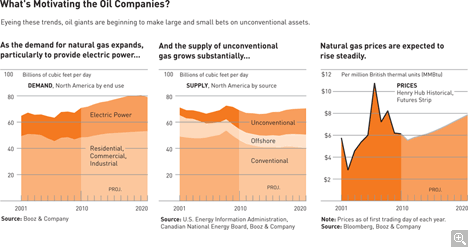Big Oil and the Natural Gas Bonanza
The oil majors hope to make major money in natural gas, but can they learn to operate two distinct types of businesses under one roof?
Just a few years ago, natural gas, like oil, was plentiful only in a few countries (some of which, such as Russia and Nigeria, were seen as less than stable), while reserves were dwindling in the West. Since then, however, that point of view has been turned on its head. Today, natural gas is abundant virtually throughout the world, thanks to new so-called unconventional reservoirs (sometimes called unconventional reserves) discovered in the U.S., China, and Europe. At the same time, increasing concerns about carbon emissions have made natural gas, which generates only half the carbon emissions of oil, a relatively clean option for some of the world’s largest energy users. For some countries, gas has become a placeholder for running trucks, buses, and power plants until renewable energy sources such as solar and wind power and advanced battery technologies become cost-efficient.
But as the green-energy geopolitics surrounding natural gas continue to be well documented, another equally intriguing phenomenon is playing out: The unexpected revival of natural gas is quietly precipitating a fundamental shift in the oil and gas industry — a shift that few companies were prepared for but that may determine the industry’s overall future makeup. It pits the major oil companies against the independents, which have plied the unconventional reservoirs doggedly over the last seven to 10 years. And it raises questions about whether the oil giants can become big players in this new unconventional gas business. To do so, they will have to develop dual operating models under one roof — one, a traditional high-risk, corporate-led exploration model, and the other, a nimble, efficient, and decentralized operation. In other industries (notably airlines), such two-headed strategies have generally failed.
Unconventional gas, which is extracted from source-rock formations, usually shale, has changed the energy equation entirely. New shale plays — discovered in the past two decades, but only accessible more recently with improved recovery techniques — created a surfeit of natural gas just as consumers around the world began to pull back precipitously in response to the global recession. As a result, natural gas prices collapsed, falling from a recent high of US$13 per million British thermal units (MMBtu) to below $5 per MMBtu a year later.
This didn’t affect big oil very much. Companies such as Exxon, BP, Statoil, and Total had significant natural gas investments, but these reserves were mostly conventional onshore or offshore sites — vast pockets of free-flowing gas usually close to oil fields that the large, integrated oil companies alone had the resources, capital market strength, healthy balance sheets, and technical and project management skills to pursue. Moreover, the energy majors held diversified portfolios with substantial oil assets — whose prices had rebounded strongly, cushioning the effect of plunging gas prices.
In contrast, smaller natural gas independents were vulnerable to falling gas prices. This was particularly true because of the billions of dollars they had spent on leases, as well as on labor and equipment to apply hydraulic fracturing and horizontal drilling, the advances in technology that made unconventional gas more economical. Not only were the independents less diversified than the oil majors, but their capital structures were far less liquid. These were clear disadvantages, since unconventional reservoirs are exploited best by pouring large amounts of cash into drilling a large number of wells and employing a continuous improvement process to gain scale and efficiency. As a result, the most successful independents in recent years were those that were able to take advantage of the best unconventional drilling opportunities quickly and cheaply. They enjoyed the lowest-cost business models possible, and dispersed, decentralized decision-making structures, allowing frontline managers to make operational choices at the wellhead without having to go back to headquarters for approval. The independents that hung on through this rocky period may be vindicated.
Although natural gas prices, just about $5 per MMBtu as of June 30, 2010, are still too low to generate consistent profits from many unconventional sources, it’s likely that prices will rise in the coming years. The U.S. Energy Information Administration forecasts prices reaching upwards of $8 per MMBtu by 2020; the breakeven price for many unconventional wells is $4 to $7 per MMBtu. Stronger demand will drive higher prices: According to Booz & Company forecasts, demand should grow at an annual rate of approximately 2 to 3 percent globally through 2020 as the world economy improves, as gas-fired plants replace relatively dirty coal plants for power generation, and as new policy rules — such as the proposed energy bill in the U.S. — encourage and mandate increased use of natural gas for transportation. International cap and trade programs, which essentially put a price on carbon, would only accelerate this growth.
Indeed, the established oil companies have begun to take notice. Realizing that the future looks as though it will be flush with natural gas, the integrated giants know that they cannot afford to ignore unconventional reservoirs. For now, they have mostly invested in partnerships, which give them access to operating capabilities, land assets, or both. For example, BG Group recently entered a 50–50 joint venture with EXCO Resources, a Dallas-based independent, to develop EXCO’s position in the Marcellus Shale in the Appalachian region of the United States. BP, Statoil, Eni, and Total have negotiated similar deals. But to truly profit from the natural gas boom over the long haul, the large oil companies are going to have to do more than merely engage in joint ventures, which inherently limit their potential gains to a percentage of royalties from gas production in a specific region.
In order to compete in unconventional assets, oil majors will have to embrace a dual operating model — in essence, pairing traditional operations with separate and more agile business units modeled after the independent gas firms, with flatter organizations, simpler governance structures, and an emphasis on efficiency and innovation. These attributes are necessary to reduce operating costs, as well as to allow the firms to quickly adapt new well designs, source local contractors and materials, and secure labor as needed.
An energy giant can attempt to gain these capabilities in two ways. The first is through acquisition. It can buy a natural gas company with the proven talents to exploit unconventional assets. ExxonMobil took this approach with its $41 billion purchase of XTO Energy in late 2009. But it’s an open question whether large, brand-name companies have a high enough tolerance for the economic risks inherent in unconventional gas exploration, which puts a premium on drilling a large number of wells with uncertain prospects. It is also uncertain whether they can resist the temptation to impose the larger organization’s more sclerotic and less entrepreneurial culture on the acquired business unit. Moreover, as BP’s disastrous recent experience with the Deepwater Horizon well in the Gulf of Mexico demonstrates, the major’s hefty balance sheets and brand value could be at risk if an accident were to occur on the unconventional business side. For all these reasons, as things stand now, the acquisition approach poses considerable challenges for the bigger energy firms.
The second option is to develop the natural gas expertise organically in-house, perhaps after gaining capabilities through a joint venture. Royal Dutch Shell was the first major oil company to attempt this, with its $4.7 billion acquisition of East Resources in May — and it’s too early to tell whether Shell will be successful. In this deal, Shell purchased access to several hundred thousand acres in the Marcellus Shale reserves in Pennsylvania. And in a separate transaction that same day, Shell acquired 120,000 acres in south Texas. The company plans to transfer Shell’s oil-field technologies and personnel skills into these unconventional gas plays.
Some industries — pharmaceuticals, for one — are better than others in implementing dual operating models. For example, Pfizer recently created a distinct business unit to engineer biotech-based drugs rapidly, the way the smaller startups in that sector can. These units have full P&L and development responsibilities, and can choose on their own whether to continue investing in particular drug candidates. But such industry dual operating model successes are rare. More common is the experience of the airline industry, in which low-cost, point-to-point carriers like Southwest and JetBlue have shaken up the cost structure and stolen market share from the “majors.” In response, large airlines launched low-cost brands such as United’s Ted and Delta’s Song. Ultimately, managing these separate subsidiaries with lower costs and more entrepreneurial cultures within a high-cost legacy carrier proved too difficult, and Ted and Song were folded back into their parent companies’ operations.
The oil companies’ success in capturing the potential of unconventional natural gas reserves (as well as unconventional oil from new oil shale assets such as the Bakken Formation in Montana and South Dakota, which the independents are starting to pursue) will depend on how well the entry strategy is executed. An acquisition approach will require that the oil company maintain the targeted natural gas firm’s decentralized operating model, while gingerly introducing elements of its own capabilities that add incremental value — such as an integrated supply chain to minimize procurement complexity. The goal should be to improve the natural gas company without destroying its culture, which in large part lets it thrive in the unconventional environment.
An organic approach will require openness to external ideas. The oil major must actively seek out new operational concepts suited to unconventional gas operations, by participating in industry conferences, hiring experts and specialists as advisors and teachers, and setting up internal training mechanisms. Above all, management will need to ensure that existing processes and structures do not discount these fresh ideas because of a “not invented here” bias. If a joint venture is part of this approach, the company will need to develop a plan that allows it to learn from the arrangement, by creating formal and informal governance mechanisms to promote the transfer and dissemination of knowledge.
If designed and managed appropriately, either strategy could be successful, but history suggests that most of the oil giants will struggle to make dual operating models coexist. Though it may not seem obvious today, many of these companies are likely to find that the technical hurdles of unconventional reserves are relatively minor. Far tougher — and ultimately out of reach for some — will be the challenge of changing behavior and culture. ![]()
Author profiles:
-
Christopher Click is a principal with Booz & Company in Dallas, where he focuses on growth and organizational strategies for the upstream sector.
-
Andrew Clyde is a partner in Booz & Company’s global energy practice in Dallas, where he leads the firm’s North American energy, chemicals, and utilities practice, and focuses on corporate and business unit strategy across energy value chains.
-
John Corrigan is a principal with Booz & Company in Dallas, where he serves clients in the area of energy market strategy.




